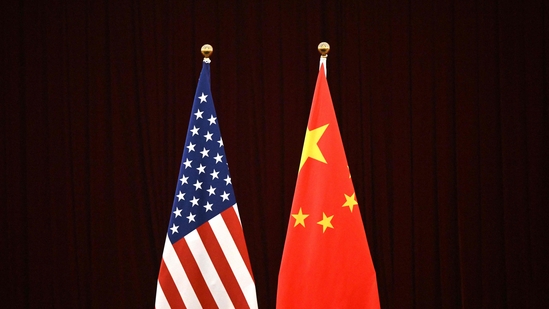
(FILES) This photo shows a gerenal view of China's and USA's flags during a meeting between US Treasury Secretary Janet Yellen and China's Vice Premier He Lifeng at the Guangdong Zhudao Guest House in the southern Chinese city of Guangzhou, on April 5, 2024. President Donald Trump on April 2, 2025 announced huge new tariffs of 34 percent on imports from China and 20 percent on imports from the European Union -- two of the main US trade partners. (Photo by Pedro Pardo / AFP)
Beijing and Washington pause tariff hostilities as Xi and Trump meet in South Korea…
China’s exports fell in October, marking the first decline in eight months, as trade tensions with the United States resurfaced just weeks before Presidents Xi Jinping and Donald Trump met in South Korea.
According to data released on Friday by the General Administration of Customs, exports dropped 1.1 percent year-on-year, defying expectations of a 2.9 percent increase, based on Bloomberg’s forecast. Imports, meanwhile, edged up 1.0 percent, significantly below September’s stronger reading and short of the 2.7 percent growth analysts had projected.
The figures reflect a cooling in global demand and renewed uncertainty surrounding the world’s two largest economies, which have sparred over trade and technology for years.
After their late-October meeting in South Korea, Xi and Trump reached a fragile truce, agreeing to suspend a number of punitive measures for one year, offering temporary relief after months of escalating tariffs and export restrictions.
Last month, Beijing imposed new curbs on exports of rare earth technologies, a sector crucial to defense and automotive manufacturing and one that China largely dominates. Washington responded with a threat to double tariffs on Chinese imports, raising the rate to 100 percent.
However, that threat was withdrawn following the leaders’ meeting, with Trump describing their first encounter since 2019 as a “great success.” In the aftermath, the United States halved its blanket tariff on Chinese goods to 10 percent, while China eased export limits on rare earths, a move welcomed by European industries dependent on those materials.
Beijing also lifted extra duties on key U.S. agricultural exports, including soybeans, offering much-needed relief to American farmers, an important constituency for Trump.
Customs data showed that China’s imports from the U.S. fell 11.6 percent month-on-month in October, while exports to the U.S. rose 1.8 percent during the same period.
Economist Zhiwei Zhang of Pinpoint Asset Management noted that Chinese exporters had been “frontloading trade” earlier in the year to avoid higher tariffs in the U.S. “It seems the frontloading finally faded in October,” he said. “As the trade war is put on hold for one year, exports will likely normalise.”
Zhang cautioned, however, that with external demand slowing, China may need to rely more heavily on domestic consumption to sustain economic growth in the coming months.



